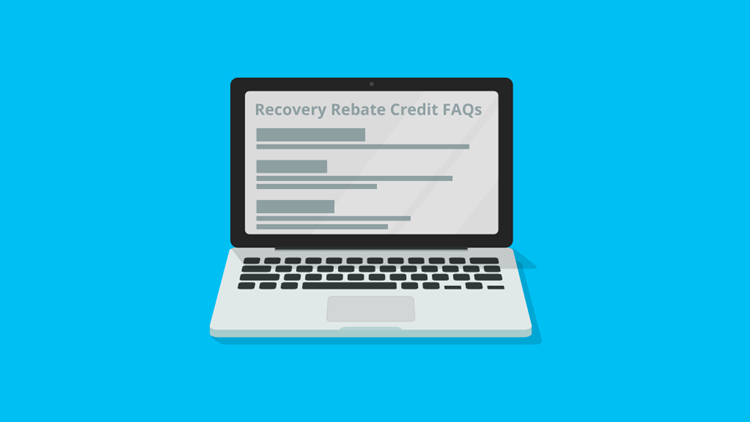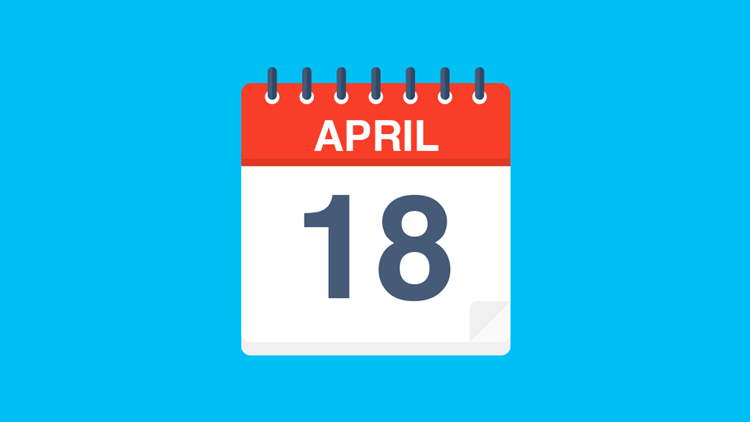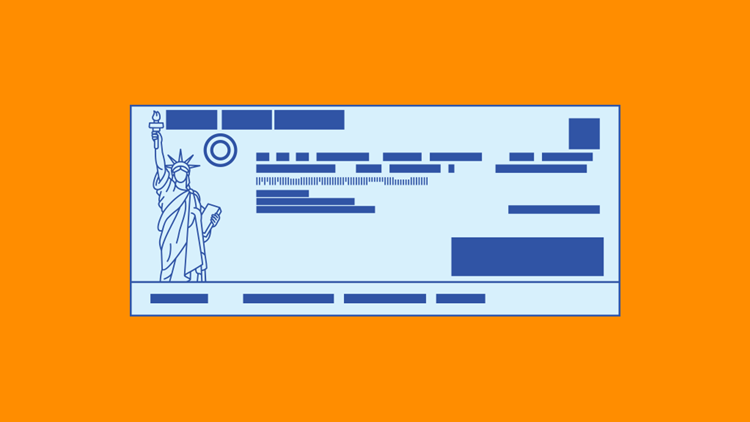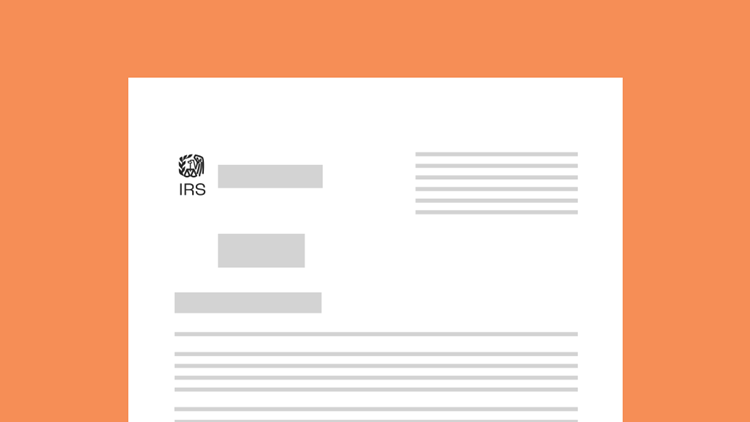by | Apr 15, 2022 | Tax Tips and News
The Internal Revenue Service wants taxpayers to know it has revised some of the frequently asked questions (FAQs) surrounding the Recovery Rebate Credit for a second time.
The newly updated information is contained in Topic E of Fact Sheet 2022-26, and covers Receiving the Credit on a 2020 tax return.
The IRS has modified Questions 1, 4, 5, and 8, while adding new material in Questions 9 and 10.

Getting the right EIP
Taxpayers who either didn’t get the full amount of a third Economic Impact Payment (EIP) or didn’t qualify for the third EIP might be able to claim the 2021 Recovery Rebate Credit based on tax information from the 2021 tax year. This could include those who may have gotten their third EIP from initial and so-called “plus-up” payments during 2021.
Taxpayers should note that payments of the third Economic Impact Payment are not the same as the advance Child Tax Credit payments the IRS sent out in monthly amounts during 2021.
Most eligible individuals have already gotten their Economic Impact Payments; if so, they won’t have to include any information about them when they file a 2021 return.
Those who missed a stimulus payment need to look over the IRS’ Recovery Rebate Credit webpage to find if they qualify for another payment or determine if they should claim the Recovery Rebate Credit for 2021.
The only way to claim any remaining credit for the 2021 tax year is to file a 2021 income tax return – even if the filer doesn’t usually file taxes. Similarly, those who didn’t receive the full amount of the first and second EIPs issued in 2020 can only get those amounts by filing a 2020 return (or amending an already-filed 2020 return) to claim the 2020 Recovery Rebate Credit.
Again, see the Recovery Rebate Credit webpage for additional information.
Getting the credit
The 2021 Recovery Rebate Credit is a refundable credit, meaning it can reduce the taxes owed by the filer; any credit amount left after the tax is paid down to zero can be included in a tax refund to the filer.
The IRS cautions, however, there are a few things filers want to avoid when claiming the 2021 Rebate Recovery Credit. Filers, they say, should be sure not to mix information from their 2020 tax year and that from 2021.
More specifically, they warn not to include any information from the first or second Economic Impact Payments, issued in 2020, or from the 2020 Recovery Rebate Credit, on their 2021 return.
What filers need is the total amount of the third Economic Impact Payment they’ve received so the filer can figure the 2021 Recovery Rebate Credit accurately when they file their 2021 tax return. The best place to get this information is in the taxpayer’s IRS online account.
This information can also be found on Letter 1444-C, which the filer should have gotten from the IRS after each payment in 2021. Letter 6475, which was mailed out in March by the IRS, also has this same information.
Source: IR-2022-82
– Story provided by TaxingSubjects.com
by | Apr 12, 2022 | Tax Tips and News
For millions of American taxpayers, the foremost question in their minds during tax season is how long it will take to get their refund.
The Internal Revenue Service has been pretty firm on the answer, maintaining that most refunds make their way into taxpayers’ accounts in 21 days or less after filing, provided the return was filed electronically and the taxpayer chose direct deposit.
There are exceptions to every rule, of course, and this is no different. There are times when a taxpayer’s refund can and will take longer than 21 days to be available.

Putting on the brakes for some refunds
What can delay a taxpayer’s refund? Here are a few of the most common issues that can slow down an otherwise speedy refund:
- The return has errors, is incomplete or is affected by identity theft or fraud.
- The return needs a correction to the child tax credit or recovery rebate credit amount.
- The return has a claim filed for an earned income tax credit, additional child tax credit, or includes a Form 8379, Injured Spouse Allocation PDF.
- The time it takes a taxpayer’s bank or credit union to post the refund to the taxpayer’s account.
Inaccurate or incomplete information on the return can also affect refund timing. The IRS notes that it “will contact taxpayers by mail if it needs more information to process their return.”
All this adds credence to the IRS caution that in spite of the hard work the agency does to get refunds out quickly, taxpayers shouldn’t bank on getting their refund by a certain calendar date.
Go online to track a refund
The IRS online tool Where’s My Refund? on IRS.gov can help taxpayers check the status of their refund. Electronic filers are urged not to be too quick on the trigger, though, as it’s best to wait 24 hours after filing before checking the status of a refund.
Paper filers need more patience, waiting four weeks after mailing their returns to checking on any refund.
Calling the IRS telephone assistance number or visiting a Taxpayer Assistance Center may not be any faster.
IRS representatives can only check the status of a refund if it’s been 21 days since the taxpayer electronically filed the return or six weeks since a paper return was mailed; or if the Where’s My Refund? tool tells the taxpayer to contact the IRS.
Source: COVID Tax Tip 2022-54
– Story provided by TaxingSubjects.com
by | Apr 8, 2022 | Tax Tips and News
For millions of American taxpayers, all that stands between them and a big tax bill when they file are estimated tax payments.
By putting away funds every quarter for their income taxes throughout the tax year, self-employed taxpayers, retirees and investors, in addition to businesses, corporations and others, help to ensure they have the means to pay their tax bill when it’s time to file.
The Internal Revenue Service reminds these taxpayers that their first-quarter payment for the 2022 tax year is due on Monday, April 18.

Pay-as-you-go taxes
The IRS describes the entire income tax system as a pay-as-you-go process, meaning taxes have to be paid as income is earned or received during the year. Wage earners have their taxes withheld from their paychecks as do taxpayers who receive pension payments, Social Security benefits or some other government payments, such as unemployment compensation.
Some taxpayers, however, don’t fit the withholding mold and so need to look elsewhere for a taxpaying option.
Enter estimated tax payments.
For self-employed taxpayers and those working in the gig economy, quarterly estimated tax payments are used because their tax payments can keep pace with the income they earn over the course of the year. On the other hand, investors, retirees and others may use estimated tax payments because a large part of their yearly income isn’t subject to withholding.
Also, not subject to withholding in most cases are interest, dividends, capital gains, alimony and rental income. Paying estimated taxes every quarter can lessen—and maybe even eliminate—any penalties.
Paying estimated taxes
Form 1040-ES, Estimated Tax for Individuals, has instructions to help taxpayers how best to figure their estimated taxes. Taxpayers can also visit IRS.gov/payments to pay their taxes electronically.
The IRS Online Account is one of the best ways to pay, since taxpayers can log in to see their payment history, any pending payments and other useful information.
Other payment options included IRS Direct Pay; Debit Card, Credit Card or Digital Wallet; or the Electronic Federal Tax Payment System (EFTPS).
Other payment options can be found online at IRS.gov/payments.
Taxpayers sending in payments by check should remember to make the check payable to “United States Treasury.”
Publication 505, Tax Withholding and Estimated Tax, has additional information helpful to taxpayers with dividend or capital gain income, owe alternative minimum tax or self-employment tax or have a special situation. Other resources include the Interactive Tax Assistant, Tax Topics, and Frequently Asked Questions.
Source: IR-2022-77
– Story provided by TaxingSubjects.com
by | Apr 5, 2022 | Tax Tips and News
Those who own or control financial or bank accounts that are in a foreign country have some reporting to do, and soon. They have to file an annual Report of Foreign Bank and Financial Accounts—also known as the FBAR—on or before April 15.
Taxpayers who miss the April deadline will get an automatic extension, pushing their FBAR filing deadline back to October 15. Since it’s automatic, there’s no need for filers to request the extension.

Filing the FBAR
The Bank Secrecy Act says U.S. persons—including U.S. citizens, resident aliens and any domestic legal entities—must file an FBAR if they have:
- Financial interest in, signature authority or other authority over one or more accounts, such as a bank account, brokerage account, mutual fund or other financial account in a foreign country, and
- The aggregate value of all foreign financial accounts exceeds $10,000 at any time during the calendar year.
The Internal Revenue Service says this threshold means it’s a good idea for U.S. owners of any foreign accounts, even if those accounts are relatively small, to check and see if the filing requirement applies to them.
The IRS says “U.S. persons” covered by the filing requirements can be any citizen or resident of the United States, or a domestic legal entity such as a partnership, corporation, limited liability company, estate or trust.
There’s only one way to file an FBAR and only one place to get it. The FBAR form is only available through the BSA E-filing system and must be filed electronically with the Financial Crimes Enforcement Network (FinCEN).
If taxpayers are unable to e-file their FBAR for some reason, they’ll have to call FinCEN at 800-949-2732 (or 703-905-3975 if calling from outside the U.S.) or they can email FinCEN at FRC@fincen.gov.
There are indeed penalties for those taxpayers who are required to file an FBAR but do not. In civil and criminal penalties can include fines and even prison time. However, the IRS won’t penalize anyone who properly reported a foreign account on a late-filed FBAR if the agency decides there was reasonable cause for the late filing.
For more information about the FBAR and filing deadlines, see the Financial Crimes Enforcement Network’s (FinCEN) website. FinCEN also has additional information about the FBAR extension.
The IRS also has other resources that can be helpful:
Source: IRS reminds holders of foreign bank and financial accounts of April FBAR deadline
– Story provided by TaxingSubjects.com
by | Apr 2, 2022 | Tax Tips and News
The Internal Revenue Service is going the extra mile to ensure taxpayers have the newest information on the third-round Economic Impact Payment.
The agency’s frequently asked questions on the third-round payment have been updated with new dates and other information so taxpayers can make better decisions. The new FAQs are published in the IRS Fact Sheet 2022-22.
The third-round Economic Impact Payment was authorized by the American Rescue Act of 2021. It was structured as an advance payment of the 2021 Recovery Rebate Credit.

Filing a 2021 income tax return is vital for those taxpayers who either did not receive the third-round Economic Impact Payment (EIP), or those who didn’t get the full amount. These taxpayers have to file a return claiming the Recovery Rebate Credit which, in effect, may give them another chance at the EIP.
The Recovery Rebate Credit can reduce any tax the taxpayer owes or can be included in their refund.
There is a wide range of updates
The IRS has updated frequently asked questions and their answers in nine different topic areas, with several updates in each topic. The updated topics include: General Information; Eligibility and Calculation of the Third Payment; Plus-Up Payments; EIP Cards; Requesting My Payment; Social Security, Railroad Retirement and Department of Veterans Affairs benefit recipients; Receiving My Payment; Reconciling on Your 2021 Return; and Payment Issued But Lost, Stolen, Destroyed or Not Received.
The IRS says it has issued all the third-round EIPs that were outstanding and due taxpayers. This includes the “Plus-Up” payments, leaving a 2021 tax return as the only way to now apply for the third-round payment.
Families and individuals in the following circumstances, among others, may not have received the full amount of their third-round Economic Impact Payment because their circumstances in 2021 were different than they were in 2020.
These families and individuals may be eligible to receive more money by claiming the 2021 Recovery Rebate Credit on their 2021 income tax return:
- Parents of a child born in 2021 who claim the child as a dependent on their 2021 income tax return may be eligible to receive a 2021 Recovery Rebate Credit of up to $1,400 for this child.
- All eligible parents of qualifying children born or welcomed through adoption or foster care in 2021 are also encouraged to claim the child tax credit—worth up to $3,600 per child born in 2021—on their 2021 income tax return.
- Families who added a dependent—such as a parent, a nephew or niece, or a grandchild—on their 2021 income tax return who was not listed as a dependent on their 2020 income tax return may be eligible to receive a 2021 Recovery Rebate Credit of up to $1,400 for this dependent.
- Single filers who had incomes above $80,000 in 2020 but less than this amount in 2021; married couples who filed a joint return and had incomes above $160,000 in 2020 but less than this amount in 2021; and head of household filers who had incomes above $120,000 in 2020 but less than this amount in 2021 may be eligible for a 2021 Recovery Rebate Credit of up to $1,400 per person.
- Single filers who had incomes between $75,000 and $80,000 in 2020 but had lower incomes in 2021; married couples who filed a joint return and had incomes between $150,000 and $160,000 in 2020 but had lower incomes in 2021; and head of household filers who had incomes between $112,500 and $120,000 in 2020 but had lower incomes in 2021 may be eligible for a 2021 Recovery Rebate Credit.
As we mentioned, the only way to get the Rebate Recovery Credit is to file a 2021 tax return; the credit will not be calculated automatically by the IRS.
Didn’t get a third-round EIP?
Those people who believe they missed out on the third-round stimulus payment can visit the Recovery Rebate Credit web page on the IRS website to figure whether they are eligible for the Recovery Rebate Credit.
Taxpayers can also go online to their IRS online account, and click on “Tax Records” to see what the IRS sent them for a third-round EIP.
The Internal Revenue Service has also sent out Letter 6475 to taxpayers, using the addresses they have on file. These letters seek to confirm the amount of the taxpayer’s third Economic Impact Payment, along with any plus-up payment they received for tax year 2021.
For more information, visit the Recovery Rebate Credit page on IRS.gov.
Information is also available about taxpayer reliance on IRS FAQs.
Sources: IRS provides revised frequently asked questions on Third-round Economic Impact Payment; Fact Sheet 2022-22
– Story provided by TaxingSubjects.com
by | Apr 2, 2022 | Tax Tips and News
Now that the Internal Revenue Service has mailed Letters 6475 to all the taxpayers who got third-round Economic Impact Payments (EIPs), there’s only one door left open to those who didn’t get the full benefit of the stimulus payments.
People have to claim any remaining third-round EIP amounts on their 2021 income tax return using the Recovery Rebate Credit.
More than 175 million third-round payments totaling over $400 billion were issued by the IRS as of Dec. 31, 2021. Since EIPs are no longer being issued, filing a 2021 income tax return claiming the Recovery Rebate Credit is the only remaining option for taxpayers.

The three EIPs were advance payments of the Recovery Rebate Credit. Most taxpayers got the full amount of the credit through the EIPs and don’t need include any information about the payments in their 2021 return.
The same goes for those taxpayers who received what’s called “plus-up” payments. These were additional payments from the IRS to those who initially got a third-round EIP based on information from their 2019 tax return, but were eligible later for a larger amount, based on their 2020 return.
How do taxpayers know the EIP amount they received?
The best way to know what Economic Impact Payments a taxpayer has gotten is to access their IRS Online Account, where the amounts were posted in the Tax Records page. In the case of married spouses filing jointly, each spouse will have to log into their own Online Account to see their part of the total payment—or check out their personal Letter 6475.
More information can be found in the Frequently Asked Questions for Topic G: Finding the Third Economic Impact Payment Amount to Calculate the 2021 Recovery Rebate Credit.
Taxpayers should check their records first
The most efficient way to check up on possible Economic Impact Payments is to simply check bank account records—especially those from early spring and summer of 2021—to see if the payment was actually received and deposited.
If a taxpayer’s IRS Online Account shows an EIP was issued (any payment greater than $0 qualifies). or if the taxpayer has a Notice 1444-C or Letter 6475 saying a payment was issued to them, but the payment was never received, they should contact the IRS as soon as possible to see if a payment trace is needed.
Note that if a payment was issued by the IRS but returned, the amount shown in the Online Account may be less that the amount in their Letter 6475. A payment trace should not be requested to find if a taxpayer was eligible for a payment, or to confirm the amount of payment they should have gotten.
If a trace is requested, there’s no need to wait until it’s complete to file a 2021 tax return. Whether completing the Recovery Rebate Credit Worksheet in the printed forms or answering EIP questions in tax software, taxpayers have two options to move forward.
They can opt to use the amount printed in their Letter 6475 or the EIP amount found in their Online Account to figure their Recovery Rebate Credit on line 30; or, the taxpayer can merely use the amount of EIP they believe they got to calculate the line 30 amount.
Either way, if the trace reveals the taxpayer in fact did not receive the Economic Impact Payment, the IRS will then automatically adjust the amount of Recovery Rebate Credit on the tax return and issue a refund as needed.
Mistake? No amended return necessary
There’s good news for taxpayers who make a mistake in figuring their 2021 Recovery Rebate Credit on line 30: the IRS says they don’t have to file an amended return to fix the error. Instead, the IRS will correct the amount and send a notice letting the taxpayer know what’s been done.
However, for those who did not claim the Recovery Rebate Credit on their 2021 returns, if the IRS shows they weren’t issued an Economic Impact Payment, they’ll have to file a Form 1040-X, Amended U.S. Individual Income Tax Return, to make their claim for the stimulus payment.
Those on the fence on whether they need to file an amended return or not can use the Interactive Tax Assistant, Should I File an Amended Return? to determine the best way forward.
Taxpayers who filed their 2021 return electronically may be able to file their amended return electronically as well. Otherwise, if they filed a paper return, they’ll have to complete the paper Form 1040-X and follow the instructions for preparation and mailing.
For more information, see the Recovery Rebate Credit page and the 2021 Recovery Rebate Credit Frequently Asked Questions on the IRS website.
Source: Letters about third-round of Economic Impact Payments issued; important steps to take for missing payments and corrections
– Story provided by TaxingSubjects.com












